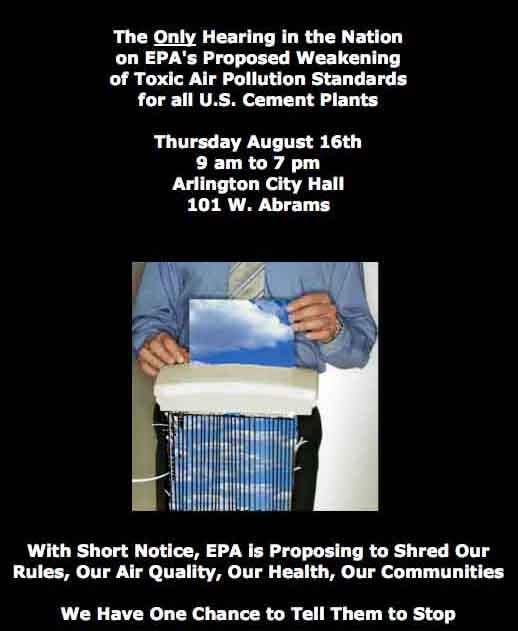cement industry
Please Take 5 Minutes to Defend What it Took Us 20 Years to Build
Nation’s Only Public Hearing on Roll Back of Cement Plant Rules Scheduled for Aug 16th in DFW
 Environmentalists are angry at EPA for giving the public less than two weeks notice prior to the nation's only hearing on a rollback of new air pollution rules for cement plants that the agency says could save thousands of lives annually, including many in DFW.
Environmentalists are angry at EPA for giving the public less than two weeks notice prior to the nation's only hearing on a rollback of new air pollution rules for cement plants that the agency says could save thousands of lives annually, including many in DFW.
One of those who came in 2009, and vowed to show up again on the 16th was Ft. Worth resident Margaret DeMoss, who was instrumental in getting her city to adopt a "green cement" policy to reduce pollution from obsolete Midlothian cement kilns in southern DFW.
She also noted that in 2009, when the rules were being proposed, there were three national hearings coast to coast. Now that the rules are being weakened, there's only one.
"It's outrageous that the EPA would schedule this hearing at the last minute and in only one location in the nation; lot of other regions suffer downwind from cement kilns. Who will speak for them?"
Downwinders at Risk and other community groups repeatedly sued to get them enforced. That effort resulted in 2010 emission rules that were hailed as the largest single advance in air quality for the US cement industry, and were universally supported by citizens living near and around the nation's cement plants.
They had already passed all necessary regulatory review, just overcome their last legal hurdle, and were on their way to President Obama for his signature and implementation by 2013 when they got yanked by the administration's Office of Management and Budget earlier this year.
When the rules re-emerged, their enforcement was pushed back to 2015 and their strict Particulate Matter pollution provisions were considerably weakened.
According to EPA's own health impact studies for the rules, that two-year delay will cause at least 2000-5000 premature deaths nationwide.
Despite a halt in the burning of hazardous wastes at local cement plants in 2010, MIdlothian remains the home of the largest concentration of cement manufacturing in the entire U.S.
Three large cement plants – TXI, Holcim, and Ash Grove – are still the largest point sources of air pollution in North Texas, generating thousands of tons of air pollution.
Since DFW is downwind of Midlothian, Metroplex residents are exposed to more cement plant pollution than any other metropolitan area in the country, and represent a disproportional number of these 2-5000 annual deaths that EPA estimates will occur because of its rules delay.
"If these revisions are adopted, DFW residents will be paying a high price for the Administration's retreat," said Schermbeck. "That's why we must make our objections heard now."
He urged those that want to speak at the August 16th hearing to reserve a five-minute slot with EPA coordinator Pam Garrett by e-mailing her at garrett.pamela@epa.gov or calling (919) 541-7966
Groups Demand DFW Hearing on EPA’s Rollback of Cement Plant Rules
 In a letter sent Tuesday, ten grassroots and national groups from across the country, including Downwinders at Risk, joined together to call on EPA to schedule a public hearing in Dallas-Ft. Worth on its proposed rollback of cement plant emission rules.
In a letter sent Tuesday, ten grassroots and national groups from across the country, including Downwinders at Risk, joined together to call on EPA to schedule a public hearing in Dallas-Ft. Worth on its proposed rollback of cement plant emission rules.
In publishing the revised rules in the Federal Register last week, EPA proposed only one public hearing be held on August 2nd in North Carolina, where there is not a single operating cement plant, although the proposed new giant Titan cement plant is trying to win permit approval to operate near Cape Fear.
Downwinders was joined by Montanans Against Toxic Burning out of Bozeman; Montana Environmental Information Center in Helena; Selkirk, Coeymans, Ravena Against Pollution (SCRAP) in upstate New York; California Communities Against Toxics, based in Rosamond, the Stop Titan Action Network, Penderwatch and Conservancy, Cafe Fear River Watch, and North Carolina Coastal Federation, all from the Tarheel state, as well as Earthjustice, the DC-based legal defense team that has partnered with Downwinders and many of the other groups for 20 years in trying to get these new rules implemented.
In 2009, DFW was one of three metropolitan areas that hosted public hearings on the then-proposed rules, referred to as National Emission Standards for Hazardous Air Pollutants, or NESHAP. Over 200 people attended at the impossible-to-get-to DFW Airport Hotel and almost 100 testified – more than participated in the DC and LA hearings combined. All but five testified in favor of strong EPA regulation of cement plant emissions.
DFW is also downwind of the nation's largest concentration of cement plant manufacturing capacity, with three large plants and a total of six kilns operating today in Midlothian, in Ellis County.
EPA's changes to the rules, which include moving the compliance deadline from 2013 to 2015, as well as loosening the Particulate Matter standards and eliminating real time monitoring of PM pollution, were proposed just as the rules were about to be finalized and signed into law. No one at EPA can explain exactly why. No judge asked them to. The public didn't demand it. The Administration seems to be going out of its way to find favor with the cement industry even as the EPA is still carrying on a massive national enforcement initiative against it.
If you haven't done so already, please click here and send your comments opposing the changes in the cement plant emission rules. You only have until August 17th.
The full text of the groups' letter:
We, the undersigned groups, respectfully request that the Environmental Protection Agency hold a public hearing in Dallas, TX on its recently re-proposed NESHAP rule for Portland cement kilns. We request that this hearing be held in addition to the hearing scheduled at the Research Triangle Park facility in North Carolina.
There are no cement plants operating in North Carolina. It is incredibly important for the EPA to hold at least one public hearing in a location that is directly impacted by the toxic air pollution that this NESHAP rule addresses. Dallas is an appropriate additional hearing location for numerous reasons. First, there are multiple cement plants in the vicinity. Second, there is a precedent for public hearings on this rule in the region— on June 17, 2009, the EPA held a productive public hearing in Dallas on the Portland cement NESHAP. Third, Dallas's central location is more convenient for other impacted citizens from across the country who wish to travel to provide testimony.
We have worked for more than a decade to secure strong protections against the emissions of mercury, arsenic and other toxic air pollutants that cement plants emit. We would appreciate the opportunity to continue our involvement on this important issue at an additional public hearing in Dallas.
German Cement Plants Now Mostly Waste Burners
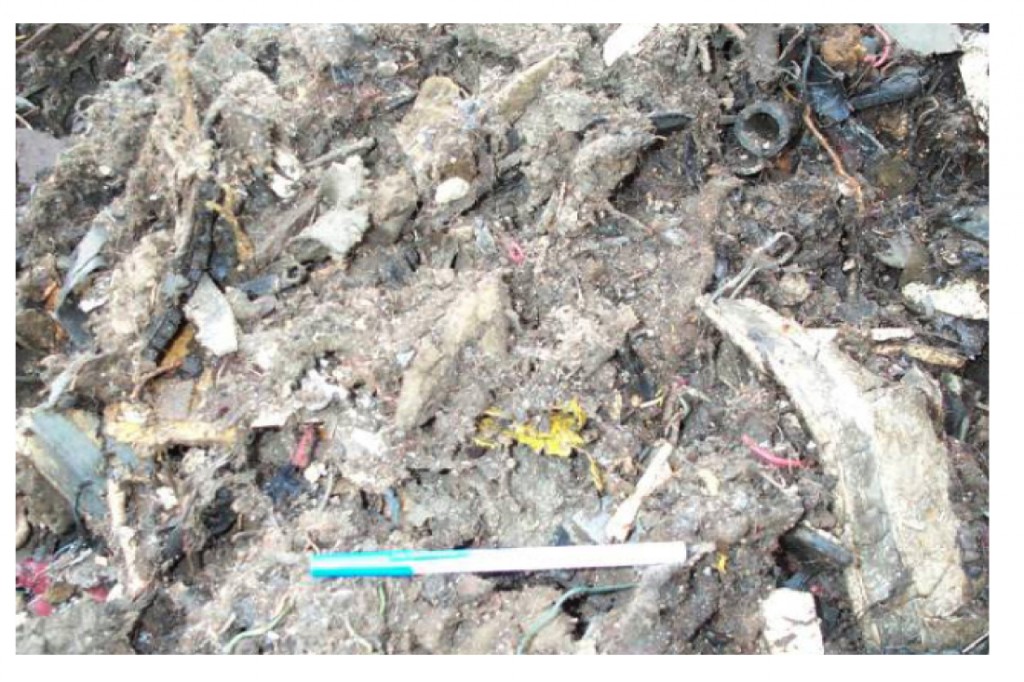 The cement industry calls it "alternative fuel" or "co-generation," but it's really just waste burning. This was true during the 1980's and 90's when the cement industry began converting kilns to large hazardous waste incinerators, and it's true now that the industry is trying to turn kilns into giant garbage incinerators. In one permit request after another across the country, cement plants are adding not just used tires and oil, but plastics wastes, automobile interiors and anything else they can get in bulk to the list of "fuels" they can burn. Locally, TXI's 2011 "permit amendment" allows the Midlothian kiln to burn a long lists of industrial wastes. To see where this leads, look no further than Germany, where fully 61% of all fuel consumed in that nation's cement kilns in 2011 was provided by plastics, used tires, and used oils. It's worth noting that European emissions requirements are usually stricter than EPA's, but the figure is still alarming since it was only about 30% in 2000.
The cement industry calls it "alternative fuel" or "co-generation," but it's really just waste burning. This was true during the 1980's and 90's when the cement industry began converting kilns to large hazardous waste incinerators, and it's true now that the industry is trying to turn kilns into giant garbage incinerators. In one permit request after another across the country, cement plants are adding not just used tires and oil, but plastics wastes, automobile interiors and anything else they can get in bulk to the list of "fuels" they can burn. Locally, TXI's 2011 "permit amendment" allows the Midlothian kiln to burn a long lists of industrial wastes. To see where this leads, look no further than Germany, where fully 61% of all fuel consumed in that nation's cement kilns in 2011 was provided by plastics, used tires, and used oils. It's worth noting that European emissions requirements are usually stricter than EPA's, but the figure is still alarming since it was only about 30% in 2000.
Another “Alternative Fuel” Fire at a U.S. Cement Plant
Following a warehouse of industrail waste that spontaneously combusted at a South Carolina cement plant last month come news from Morga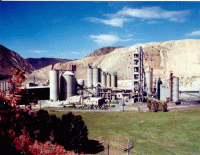 n, Utah that a semi and part of the "auxilary fuel" builing at Holcim's Devil's Slide cement plant caught fire while waste was being pumped from the truck. No injuries were reported. Expect more of these kinds of accidents as mixed industrial garbage is funneled into cement plants as "fuel.".
n, Utah that a semi and part of the "auxilary fuel" builing at Holcim's Devil's Slide cement plant caught fire while waste was being pumped from the truck. No injuries were reported. Expect more of these kinds of accidents as mixed industrial garbage is funneled into cement plants as "fuel.".
Why Isn’t This Happening in Midlothian?
 A Zachary Construction Company-owned San Antonio cement plant is finally going forward with the nation's first full-scale carbon capture plant .
A Zachary Construction Company-owned San Antonio cement plant is finally going forward with the nation's first full-scale carbon capture plant .
Austin-based Skyonic Corp. will build a $125 million facility by 2014 to recycle 15% of the cement plant's CO2 emissions, or about 83,000 tons a year, into less-harmful byproducts such as bicarbonate soda. It also promises to filter acid gases and heavy metals pollution out of the kiln's plume.
Skyonic has a patented process called "SkyMine" that it says converts carbon dioxide emissions into baking soda and can be retrofitted to any industrial plant. The company received $25 million in stimulus funding from the Department of Energy toward the final cost of the San Antonio facility.
The project was first announced in 2010, but had trouble attractign addtional private funding until now.
Cement plants are among the largest point sources of CO2 on the planet, and the industry as a whole accounts for just over 5% of the world's human-made CO2 . Kilns are among the first wave of facilities that had to inventory their Greenhouse Gas pollution for EPA in 2010, and are expected to be targeted for actual reuductions in the future.
Modernization among the three large cement plants in Midlothian has reduced their carbon foot print over the last 20 years, but they still remain the largest point sources for CO2 pollution in North Texas, with over two million tons of emissions annually self-reported by Ash Grove, Holcim, and TXI in that 2010 inventory – the latest we have.
Failing the Test on Smog
 This is a response to statements in this.
This is a response to statements in this.
1) "The downward trend" that Mr Clawson of TCEQ says has only been "interrupted," is, in fact continuing, and he knows this because it's TCEQ monitoring that's proving it. This last March saw the highest ozone levels ever recorded for that month since TCEQ air quality monitoring began in 1997. It's only June, and there are already two monitors whose three-year runing average "Design Value" is above the old 85 ppb standard. The "best ever" ozone summer we were supposed to experience this year, according to TCEQ's prediction to EPA submitted in December, is completely off the rails.
2) The "87 ppb" Design Value Mr. Clawson cites is from 2010. Last year it was 92 ppb – at the Keller monitor. This year so far, the Keller monitor is already at a Design Value of 87, a violation of the old standard and something TCEQ said would not happen.
3) The NCTCOG claim that,"the DFW region has a tougher time than other metropolitan areas in the U.S. because of its climate plus its position downwind from outside sources of pollution" is also misleading. Houston is a hotspot for bad air, and yet last year DFW exceeded the number of bad air days and the severity of the violations in that city. Other metropolitan ares downwind of power plants as well as DFW, and yet they've all managed to do better in achieving cleaner air. Atlanta, Phoenix, and other Sunbelt cities that started out at the same smoggy spot a decade ago have all conquered the old 85 ppb std. DFW has not. It's already blown it again this year. Instead of blaming climate or coal plants, it is more realistic to blame DFW's air quality failure on a lack of political will by local and state officials to get serious about decreasing air pollution.
However, there is one large area of policy where the excuses of lack of will and new downwind sources collide – in the official lack of attention paid to the rise of Barnett and Haynesville Shale gas pollution as a source of smog in DFW.
4) The statement that only "5 percent" of the smog-forming emissions in DFW come from oil and gas drilling and production is also highly misleading. First, we know this is one of the fastest-growing categories of air pollution over the last decade. The increase in gas pollution is erasing decreases in emissions from other sources. Second, according to the information submitted by TCEQ to EPA last December, oil and gas emissions are the second largest source (20%) of smog-forming Volatile Organic Compounds, or VOCs in the 9-county DFW non-attainment area. That's more than the total VOCs produced by all on-road vehicles in the same 9 county area. Based on recent field studies by NOAA and others, this is probably an underestimate.
This statement also ignores the impact of gas emissions to the south and east of DFW, like Freestone County's, that are not included in the 9-county area inventory, but are probably influencing air pollution here.
What's always left out of this pie chart is the fact that cars now have a removal efficiency of approximately 90%. No other major sources come close to that kind of effort, despite technology being available to achieve it – at cement kilns, gas operations. and coal plants. That's where "the lowest hanging fruit" remains. But since all those industries are large contributors to the politicians directing the status quo, there's no political will to target them. Exhibit A: the 2011 DFW clean air plan submitted by the state, which relies primarily on marketplace forces to replace old cars with new ones, instead of any new round of pollution controls for any industry sources.
5) The NCTCOG claim that "monitors in the north Dallas and Frisco areas have had the highest readings of the region but the plume seems to be shifting west" is also based on old data. In fact, the opposite is occurring. Violating monitors are moving EAST (just like gas mining). And there are more of them. From 2008 to 2010, Eagle Mountain Lake and Keller were the epicenter of smog in DFW. But in 2011, while Keller tripped the std, EML did not. Moreover, during that same 08-10 period there were only 1-3 monitors in violation of that std. Last year, there were seven. And they included not just Keller and Parker County, but Denton, Grapevine, Pilot Point, Frisco and North Dallas – directly in contradiction to the NCTCOG claim.
This year, the very first monitor to record four "exceedances" of the 85ppb std was located near Mockingbird and I-35 in Central Dallas – the first time that monitor has done so since 2005. Moreover, the fourth exceedance came in June – the earliest that has happened since 2006, when 12 out of 19 monitors were in violation at the end of the summer.
As much as the officials and agencies would like us all to ignore the summer of 2011 and think of it as an aberation, it would be more prudent to see it as another warning sign that DFW needs to do much more to get safe and legal air.
Wastes Waiting to Be Burned in Kiln Ignite Unauthorized Fire
What local news reports called a "massive fire" swept through the piles of industrial wastes waiting to be burned at the Argos Cement Plant in Harleyville South Carolina yesterday. Ten workers escaped injury, but the fire was so intense that it required the assistance of outside fire departments totaling 75 firefighters, three trucks and two aircraft, and lasted all day as crews snuffed out hot spots.
Starting at about 5 in the morning, the fire quickly engulfed the 60 by 100 foot warehouse stuffed with carpet pieces, paper, and rubber ready to be put into the cement kiln as "fuel." Imagine a landfill or tire fire and that's the kind of heat, smoke and toxicity you've got to deal with when your "recycled fuel" goes up in flames.
Of course, health officials denied there was any risk of exposure to toxic fumes even as they were still trying to determine exactly what was in the warehouse. That's the deductive reasoning process in action when it comes to local officials in company towns. Harleyville is home to the second-largest concentration of cement manufacturing in the country, behind only Midlothian. It hosts two large plants – Argos and Giant. It's also been a center of kiln waste-burning since the 1980's
The kinds of wastes that caught fire in South Carolina are among those that TXI now has a permit to burn in its Midlothian cement plant, along with car interiors and plastic garbage. A permit that did not offer any public comment or hearing opportunity. The Ash Grove and Holcim Midlothian cement plants also burn industrial wastes including tires and used oil. In the mid-1990's a tire "recycling" firm in Midlothian connected to the cement plants caught fire and burned for days with the black smoke wafting through downtown Dallas skyscrapers.
Halfway to Failure
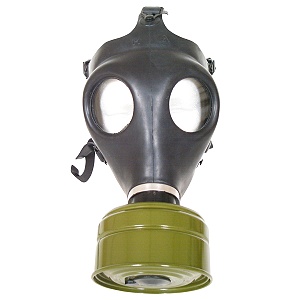 (Late Monday evening update: It's clear that the Hinton Street monitor will record its third "exceedence" of the 85 ppb standard this year, putting it just one away from making the entire region non-attainment" in 2012.)
(Late Monday evening update: It's clear that the Hinton Street monitor will record its third "exceedence" of the 85 ppb standard this year, putting it just one away from making the entire region non-attainment" in 2012.)
It's a bad sign when there are ozone problems on the weekends. It means that even with less people on the road and many businesses on less than full throttle, there's still enough pollution to cause trouble. And it usually means a rough week ahead. That's what happened on Sunday, when summer finally caught up with DFW in a big way.
Four area ozone monitors set new annual highs set on Sunday, and many others saw very alarming numbers during the afternoon. There were three "exceedences" of the old 1997 85 parts per billion ozone standard, and one of those was the second time the Dallas Hinton Street site had seen an 8-hour average above 85 this year. Six other monitors have already had their first. And it's only June.
Four such exceedences within a year puts a monitor in official violation of the obsolete standard that DFW is still struggling to meet. So with the Hinton Street results, we're already halfway to being out of compliance with the 1997 standard again. But it's all academic. Everything is now geared toward meeting the new 75 parts per billion ozone standard by 2018. DFW could be in violation of the old standard every year from now until then, and except for the terrible toll on public health, there'd be no penalty from either the EPA or TCEQ.
On the other hand, its going to be pretty hard to meet that new, harder standard when you haven't been meeting the old, easier one.
The state's official response is mostly to sit back and hope that DFW drivers trade in their older, more polluting cars for cleaner, newer ones. That phenomena was supposed to be responsible for making this year the best one for clean air in decades. According to the Texas Commission on Environmental Quality's computer modeling, no DFW monitor will violate the Clean Air Act for ozone pollution in 2012. At least, that's what they told the EPA when they submitted the region's clean air plan to the feds in December. And the EPA bought it. Because the TCEQ computer modeling said everything was hunky-dory.
But reality has a way of rudely intruding on TCEQ's computer modeling. Only six months into the new plan and most of the DFW monitor averages predicted by the state are already underestimates. We had the highest ozone levels ever recorded in March. Maybe there's just not enough of you trading in your cars.
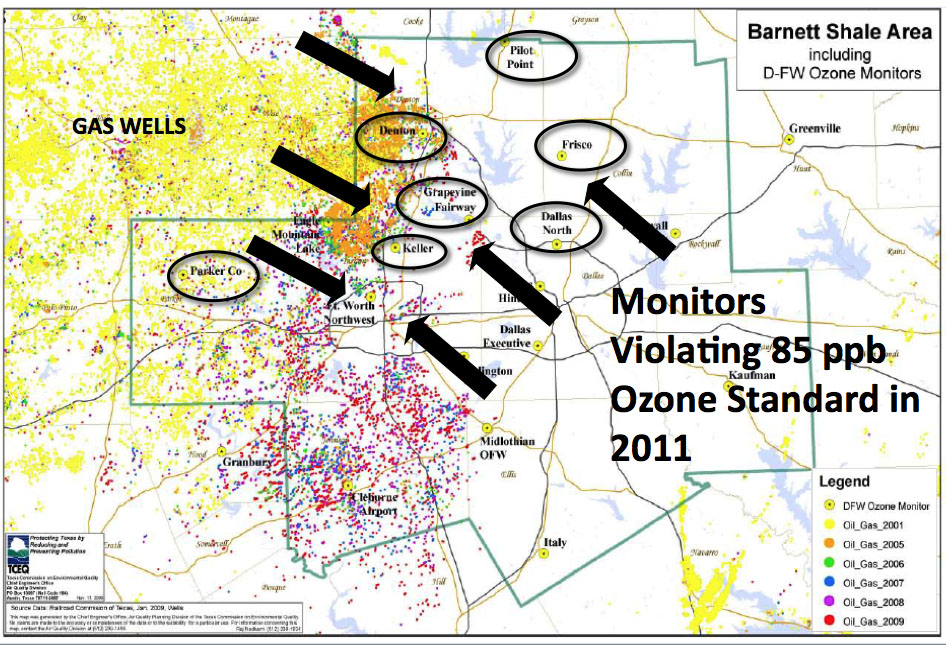 Or maybe it's just that old TCEQ junk science at work. One thing we know the state's computer model didn't consider was how already-dirty air makes the VOC pollution from natural gas operations more easily convert into ozone pollution. Denver officials who are also dealing with new gas operations contributing to long-standing smog problems have considered this factor and think it explains larger than expected ozone readings there.
Or maybe it's just that old TCEQ junk science at work. One thing we know the state's computer model didn't consider was how already-dirty air makes the VOC pollution from natural gas operations more easily convert into ozone pollution. Denver officials who are also dealing with new gas operations contributing to long-standing smog problems have considered this factor and think it explains larger than expected ozone readings there.
TCEQ chose to ignore this variable. Supposedly because the gas patch was well west of DFW and "couldn't possibly" affect North Texas ozone levels. But as anyone who's driven I-30 or I-20 over the past ten years can tell you, the gas patch extends all the way from east of Denton to Grand Prairie to Midlothian, encompassing most of the 9 county non-attainment area. In the same December 2011 clean air plan the state predicted record-low ozone levels this year, it also estimated that gas industry sources were emitting 34 tons per day more smog-forming VOC pollution than all the cars and trucks in DFW combined.
It was a political decision not to look at how dirty air from Houston, the East Texas coal plants, the Midlothian cement kilns and everything else east of Weatherford makes gas industry emissions more likely to cause ozone in North Texas. TCEQ's clean air plans are always full of such decisions that drive the final results of its supposedly objective computer modeling. Hard to believe now, but there was a time in the not-so-distant-past that the same computer modeling made it clear that the Midlothian cement plans "couldn't possibly" be affecting DFW ozone levels.
A plan to meet the new 75 ppb standard must be submitted to EPA by 2015 to show three years of compliance by 2018. That's only two-years away. If new cars alone can't get us down below 85, it will be extremely difficult for the state to argue they can get us down to 75. More actual things that work to reduce pollution will be necessary. Including bringing better controls to the cement kilns and coal plants and other industries still putting out way too much pollution. It will be a fight. but so far, the evidence is that more is needed if DFW is ever going to have safe and legal air.
Clean Air As Political Football
 Yesterday's Senate vote on rolling back the new EPA Mercury rules for power plants is a great example of how both sides use fake controversies to puff-up their political bone fides and financial support.
Yesterday's Senate vote on rolling back the new EPA Mercury rules for power plants is a great example of how both sides use fake controversies to puff-up their political bone fides and financial support.
At issue is another move by Senator Inhofe of Oklahoma to gut the widely popular regulations that would establish limits for mercury pollution from power plants – the largest source of the air-borne poison in the US.
Inhofe's motives are pretty clear – this is just one more run at trying to deconstruct the EPA and the last 40 years of government-mandated clean air provisions. This is what the Senator does. Even when he knows he doesn't have the votes to win weeks in advance, as was the case with this vote. Why? Because it's a presidential election year and the EPA is red-meat to the Republican Party core constituency. After a week of publicity about the rules and the chance to demagogue against them, the vote itself is a mere formality. In fact, losing the vote gives the Senator a chance to say that the only way to permanently get rid of these kinds of awful business-killing EPA regulations is to elect a Republican president and Senate. Get those fundraising letters out. Mission accomplished.
Likewise, many of you probably received urgent appeals from large national environmental groups to e-mail your Senators about this power plant vote or risk losing the rules. This too was political posturing. If you'd been keeping track of the debate, you knew Senator Inhofe did not have the votes to win in the Senate. And even if he had somehow won, the President still would have vetoed the bill. The rules themselves were never in any danger. So why send out urgent appeals? Because it's a presidential election year and the Republican threat to EPA is a red meat issue to a core Democratic/Environmental constituency. After a week of scaring people into believing the rules were in jeopardy, the vote itself was a mere formality. And the "closeness" of the vote means that the only way we can protect rules like these is to keep a Democratic president and Senate. Cue those fundraising appeals. Mission accomplished.
Tomorrow, it's very likely that the Obama Administration will begin the self-inflicted process of dismantling parts of the EPA's new emission rules for cement plants that Downwinders and others have worked almost two decades to see implemented. These rules govern Mercury emissions too – cement plants are also a major source. For no reason that anyone in the environmental establishment in DC can understand, the EPA is going out of its way to weaken and delay these rules. This is not a drill. This is actually happening. And it's not the fault of Senator Inhofe this time. It's the Obama EPA. But the Senator won't be crowing about it because it doesn't conform to his own popular narrative about an anti-business EPA. We'll wait and see, but we also imagine there won't be any urgent national calls from Washington environmental groups next week to stop the EPA from eating its own and save the cement plant rules. That's not the narrative they're trying to sell either.
But it's the one taking place on the ground in Midlothian and another two dozen or so communities across the country that were depending on these rules to make their lives less miserable.

